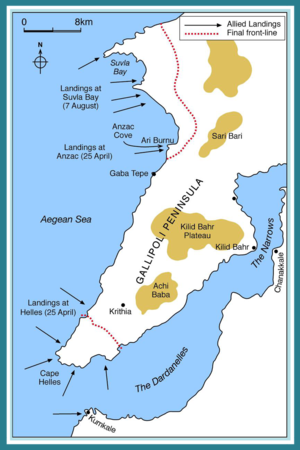
Gallipoli, 1915.
When the Allies launched their attempt to force their way through the Bosphorus at the end of April 1915, Irish Regiments were initially represented by three battalions:
1st Bttn, Royal Munster Rifles - 86th Infantry Brigade, 29th Division.
1st Bttn, Royal Dublin Fusiliers - 86th Infantry Brigade, 29th Division.
1st Bttn, Royal Inniskilling Fusiliers - 87th Infantry Brigade, 29th Division.
Read an account of the Munsters' landing at "V" Beach here.
After the initial landings, 29th Division were then involved in bitter fighting at Krithia, a few miles inland from Cape Helles, for the first three months of the campaign.
In August 1915, 10th (Irish) Division arrived in Turkey and were involved in the disastrous landings at Suvla Bay and 29th Division were also moved from Helles to the Suvla front.
As stalemate continued on the Gallipoli peninsula into the autumn, 10th (Irish) Division moved to the Salonika front and the remaining Irish battalions in 29th Division were eventually evacuated to Egypt when the final elements of the Allied forces left Gallipoli in early January 1916.
Read the history of 10th (Irish) Division at Gallipoli here.
Subsequent movements of the three Irish Battalions of 29th Division are listed below.
1st Bttn, Royal Munster Rifles - 86th Infantry Brigade, 29th Division.
Arrived in France with the Division in March 1916.
Transferred to 48th Infantry Brigade, 16th (Irish) Division in May 1916.
1st Bttn, Royal Dublin Fusiliers - 86th Infantry Brigade, 29th Division.
Arrived in France with the Division in March 1916.
Transferred to 48th Infantry Brigade, 16th (Irish) Division in October 1917.
1st Bttn, Royal Inniskilling Fusiliers - 87th Infantry Brigade, 29th Division.
Arrived in France with the Division in March 1916.
Transferred to 109th Infantry Brigade, 36th (Ulster) Division in February 1918.
Gallipoli: the final resting place ... http://t.co/CqxlZ0je9c via @IrishTimes
— Combined Irish. (@CirAssn) October 22, 2014


